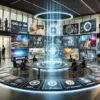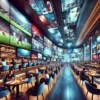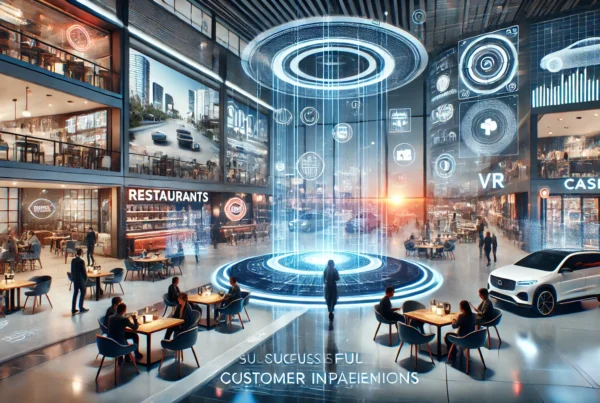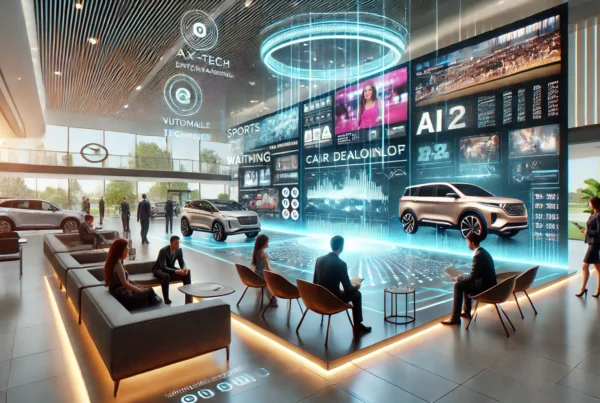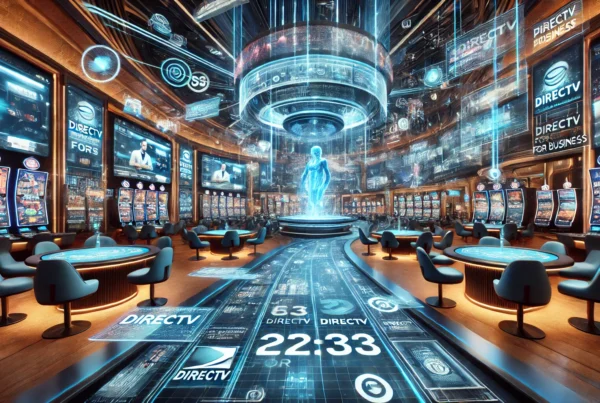As we step into 2025, the landscape of on-premise entertainment is set to undergo a transformative evolution. Imagine walking into a bustling casino, where the atmosphere is electrified by cutting-edge technology and immersive experiences. This isn’t a scene from a sci-fi movie but a glimpse into the future of how businesses engage with their clientele. The question is, how can industries like hospitality, gaming, and automotive harness these future trends to captivate and retain their audiences?
For business owners and decision-makers, understanding these emerging trends is not just about staying relevant—it’s about thriving in a competitive market. As consumer expectations rise, embracing innovations that enhance customer satisfaction and drive repeat visits becomes imperative. Technologies like virtual reality (VR), augmented reality (AR), and artificial intelligence (AI) are not only enhancing engagement but also redefining how venues interact with their patrons.
At Sports Direct, our mission is to provide exceptional video programming solutions that empower businesses to thrive in this dynamic landscape. By exploring the dynamic world of on-premise entertainment, businesses can unlock new opportunities for growth and customer engagement. This blog post will delve into the most promising innovations set to revolutionize on-premise entertainment, such as personalized content and social spaces that foster community interaction.
Are you ready to dive into the future and discover how these technologies can reshape your business model? Join us on this exciting journey as we uncover the potential of these advancements to create unforgettable experiences for your customers.
Emerging Technologies Redefining On-Premise Entertainment
As we approach 2025, the landscape of on-premise entertainment is being dramatically reshaped by emerging technologies. Among these, virtual reality (VR) and augmented reality (AR) stand out as transformative forces, offering businesses innovative ways to engage and captivate their audiences. These technologies are not just enhancing entertainment experiences; they are revolutionizing how venues interact with their patrons, creating immersive environments that were once the realm of science fiction.
For business owners in the hospitality, gaming, and automotive industries, understanding and integrating these technologies is crucial. They offer a competitive edge by attracting tech-savvy consumers and encouraging longer visits. As we delve into the potential of VR and AR, we will explore successful implementations and the benefits these technologies bring to businesses seeking to thrive in the evolving entertainment landscape.
Virtual Reality: Crafting Immersive Experiences
Virtual reality has emerged as a powerful tool for creating immersive experiences in on-premise entertainment. By transporting users to entirely new worlds, VR offers scenarios that would otherwise be impossible. For instance, casinos are leveraging VR to simulate the vibrant atmosphere of a bustling Vegas casino floor, complete with authentic sights and sounds. This not only attracts a younger, tech-oriented audience but also enhances the traditional gaming experience.
Restaurants and bars are also tapping into VR to offer unique dining experiences. Imagine enjoying a meal while being virtually transported to a serene vineyard or a lively cityscape. Such experiences significantly enhance customer engagement and satisfaction. According to a study by PwC, the VR industry is expected to grow by 30% annually, indicating a robust future for this technology in entertainment venues.
Augmented Reality: Enhancing Real-World Interactions
Unlike VR, augmented reality overlays digital content onto the real world, enriching the physical environment rather than replacing it. This technology is being used in various ways to enhance customer experiences. For example, auto dealerships are utilizing AR to allow potential buyers to visualize customizations on vehicles in real-time, providing a more interactive and personalized shopping experience.
In the hospitality industry, AR is being deployed to offer guests interactive hotel tours or provide additional information about menu items in restaurants. By blending digital content with the physical world, AR creates a dynamic and engaging environment, leading to increased customer satisfaction and loyalty. As noted by Deloitte, AR is becoming a key differentiator in competitive markets, offering businesses a way to stand out and attract new customers.
Case Studies: Successful Implementations of VR and AR
Several venues have successfully integrated VR and AR into their operations, setting benchmarks for others in the industry. The MGM Grand in Las Vegas, for instance, has implemented VR gaming zones that offer guests a thrilling and immersive experience. This initiative has not only increased foot traffic but also enhanced the overall guest experience, leading to higher retention rates.
Similarly, the automotive giant BMW has adopted AR in its showrooms, allowing customers to explore and customize vehicles virtually. This has streamlined the sales process and improved customer satisfaction by providing a more personalized experience. These examples highlight the potential of VR and AR to transform the on-premise entertainment landscape, offering businesses innovative ways to engage their audiences and drive growth.
Personalization in On-Premise Entertainment
In the rapidly evolving landscape of on-premise entertainment, personalization has become a cornerstone for enhancing customer experiences. As businesses strive to meet the unique preferences of their audiences, the integration of data analytics and artificial intelligence (AI) is revolutionizing how entertainment venues operate. By tailoring experiences to individual preferences, businesses can significantly boost customer satisfaction and foster long-term loyalty.
Personalization in on-premise entertainment is not just a trend; it’s a strategic approach that leverages technology to create memorable and engaging experiences. Whether it’s a restaurant, casino, or auto dealership, understanding and anticipating customer needs can transform a visit into an unforgettable journey. Let’s delve into how data and AI are reshaping the future of on-premise entertainment.
The Role of Data in Personalizing Experiences
Data is the backbone of personalization. By collecting and analyzing customer data, businesses can gain valuable insights into preferences, behaviors, and trends. This information allows venues to offer tailored experiences that resonate with individual guests. For instance, casinos can use data analytics to customize gaming experiences, offering personalized game recommendations or exclusive promotions based on a player’s history.
Restaurants and bars can also benefit from data-driven personalization. By analyzing customer preferences, they can curate personalized menus or suggest pairings that enhance the dining experience. According to a report by McKinsey, companies that excel in personalization generate 40% more revenue from those activities than average players. This highlights the significant impact of data-driven strategies on business success.
AI-Driven Personalization: Enhancing Customer Engagement
Artificial intelligence plays a pivotal role in elevating personalization efforts. AI algorithms can process vast amounts of data to identify patterns and predict customer preferences with remarkable accuracy. This enables businesses to offer real-time personalized experiences that adapt to changing customer needs.
For example, auto dealerships can use AI to provide virtual tours tailored to a customer’s specific interests, enhancing the car-buying experience. Moreover, AI-powered chatbots and virtual assistants can offer personalized customer support, providing instant assistance and recommendations. This not only improves customer satisfaction but also frees up staff to focus on more complex tasks. As noted by Gartner, AI will handle 85% of customer interactions by 2025, underscoring its growing importance in personalization.
Examples of Personalized Experiences Across Industries
Various industries are successfully implementing personalization strategies to enhance customer experiences. In the hospitality sector, hotels are using data to offer personalized room settings and amenities, ensuring a comfortable stay for each guest. Casinos are leveraging AI to create personalized gaming experiences, while auto dealerships are providing customized virtual showrooms that cater to individual preferences.
These examples demonstrate the versatility and effectiveness of personalization in on-premise entertainment. By harnessing the power of data and AI, businesses can create unique and engaging experiences that not only meet but exceed customer expectations. As we look to the future, personalization will continue to be a driving force in shaping the entertainment landscape.
The Role of Social Spaces in Enhancing On-Premise Entertainment
In the evolving landscape of on-premise entertainment, social spaces are emerging as pivotal elements that enhance customer experience and encourage longer visits. These spaces are not merely about providing a place to relax; they are designed to foster interaction, community, and engagement, transforming venues into vibrant social hubs. As businesses in the hospitality, gaming, and auto industries strive to differentiate themselves, integrating well-designed social spaces can significantly enhance their appeal.
By creating environments where customers can socialize, relax, and enjoy entertainment, businesses can increase foot traffic and customer retention. Let’s delve into how these social spaces are reshaping the future of on-premise entertainment.
Creating Social Hubs: The Benefits and Examples
Social hubs within entertainment venues offer numerous benefits, from boosting customer satisfaction to increasing revenue. By providing comfortable and engaging environments, these spaces encourage guests to spend more time on the premises, which often translates to higher spending. For instance, a casino with a stylish lounge area can attract guests who may not be interested in gambling but are looking for a place to unwind and socialize.
Successful examples of social spaces can be found across various industries. In the hospitality sector, restaurants and bars are incorporating communal tables and cozy seating areas to foster a sense of community among patrons. Similarly, auto dealerships are creating lounges with complimentary refreshments and entertainment to make the car-buying process more enjoyable. These examples illustrate how social spaces can enhance the overall customer experience, making venues more attractive and inviting.
Designing for Interaction: Key Elements of Effective Social Spaces
The design of social spaces plays a crucial role in their effectiveness. Key elements include comfortable seating, ambient lighting, and interactive features that encourage guests to linger and engage with their surroundings. For example, incorporating digital screens that display interactive content or live events can create a dynamic atmosphere that captivates visitors.
Moreover, the strategic placement of social spaces within a venue can maximize their impact. Positioning these areas near high-traffic zones or integrating them with other entertainment offerings can enhance their visibility and accessibility. By thoughtfully designing social spaces, businesses can create environments that not only attract but also retain customers, ultimately boosting their competitive edge.
Leveraging Technology to Enhance Social Interactions
Technology is a powerful tool in enhancing social interactions within on-premise entertainment venues. By integrating digital solutions such as mobile apps, businesses can offer personalized experiences that cater to individual preferences. For instance, a mobile app that allows guests to order food and drinks directly to their table can streamline service and enhance convenience.
Furthermore, technology can facilitate social interactions by enabling guests to share their experiences on social media or participate in interactive games and events. This not only enhances the customer experience but also serves as a marketing tool, as guests share their positive experiences with a broader audience. By leveraging technology, businesses can create social spaces that are not only engaging but also memorable.
Charting the Path Forward in On-Premise Entertainment
As we look ahead to 2025, the landscape of on-premise entertainment is ripe with opportunities for innovation and growth. The trends we’ve explored, from virtual reality (VR) and augmented reality (AR) to AI-driven personalization and vibrant social spaces, are not just reshaping how businesses engage with their customers—they’re setting new standards for what customers expect. For industries such as hospitality, gaming, and automotive, embracing these future trends in on-premise entertainment is crucial for staying competitive and relevant.
Businesses that integrate these advanced technologies can create immersive experiences that captivate audiences and encourage longer visits. The use of VR and AR, for example, allows venues to offer unique and interactive environments that were once unimaginable. Meanwhile, harnessing the power of data and AI can personalize experiences to meet individual customer preferences, significantly enhancing satisfaction and loyalty.
Equally important is the role of social spaces in fostering community and engagement within these venues. By designing areas that encourage interaction and relaxation, businesses can boost foot traffic and customer retention. These social hubs not only enhance the overall customer experience but also differentiate venues in a crowded market.
- Immersive Technologies: Leverage VR and AR to create captivating experiences.
- Data-Driven Personalization: Utilize AI and analytics to offer tailored experiences.
- Social Spaces: Design interactive hubs that foster community and engagement.
As we chart the path forward, it is essential for businesses to stay informed and proactive in adopting these trends. We invite you to explore more about these innovations and how they can be integrated into your business strategy by visiting Sports Direct. By embracing these advancements, your venue can become a hub of innovation and excitement, ensuring it remains at the forefront of the entertainment revolution. Share your thoughts and experiences in the comments below, and let us know how you envision the future of on-premise entertainment. Together, let’s shape the future of this dynamic industry.



